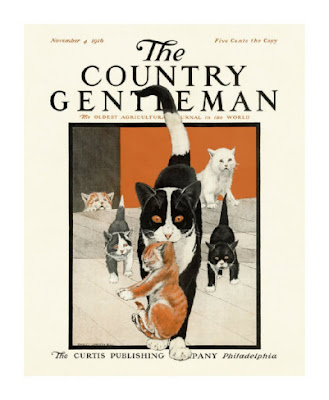In
her introduction, Yonge says that de la Motte Fouqué intended some of his
stories to reflect specific seasons. Undine
is a story about spring, while “the stern, grave ‘Sintram’” is a winter tale.
Yonge is right: Sintram is mainly set
in the cold, dark heart of winter. It’s the story of Sintram, the son of a
brutal knight and a saintly nun, who spends his life torn between those two
influences. Sometimes Sintram gives in to his violent side and joins his father
in burning and pillaging villages; at other times he is overwhelmed by guilt
and spends his time in solitary prayer, and it’s not clear which side will win
out. Sintram finds himself in particular difficulties when a French knight and
his wife – Folko and Gabrielle – come to Norway and become guests at his father’s
castle. Sintram wants to be like Folko, who is the epitome of the chivalrous,
courtly knight, but he is tempted by his lust for the beautiful Gabrielle.
(Sintram being knighted by Folko, illustrated by Gordon Browne.)
I
found this story difficult to read, and the character of Sintram difficult to
like. But I did like the wildness of the landscape and the characters – I love
that Sintram is so wild and strong, for example, that he would break the
strings of a regular harp, and so he has to play music on a special giant harp
strung with bear-sinews. And I liked the creepy, supernatural aspects of the
story. According to Yonge, Sintram is
inspired by a 16th-century Dürer engraving called “Knight, Death and
the Devil,” which shows a warrior on horseback accompanied by Death, who looks like a skeleton
crowned with serpents, and the Devil, a little horned creature with a goat-like
face. These creepy figures are Sintram’s companions, although they change their
appearance throughout the book.
(Albrecht Dürer, "Knight, Death and the Devil.")
Death
usually looks like a tall, pale man dressed like a pilgrim, with clattering bones
hung all over his robes. The best dialogue in the book occurs when he talks to
Sintram, as in this scene when Sintram is giving him a ride back to the castle:
“’Draw
thy garment closer around thee, thou pale man, so the bones will not rattle,
and I shall be able to curb my horse.’
‘It
would be of no avail, boy; it would be of no avail. The bones must rattle.’
‘Do
not clasp me so tight with thy long arms, they are so cold.’
‘It
cannot be helped, boy; it cannot be helped. Be content. For my long cold arms
are not pressing yet on thy heart.’”
(Gordon Browne's illustration of the tall, pale pilgrim.)
The
Devil, on the other hand, appears in the form of a little man dressed in fur,
with one long feather in his cap. When he first meets Sintram he claims that he
is a snail-hunter:
“’Why
should you find fault that I go hunting here for snails? … I know how to
prepare from them an excellent high-flavoured drink; and I have taken enough for
to-day; marvelous fat little beasts, with wise faces like a man’s, and long
twisted horns on their heads. Would you like to see them? Look here!’
And
then he began to unfasten and fumble about his fur garment; but Sintram, filled
with disgust and horror, said, ‘Psha! I detest such animals! Be quiet, and tell
me at once who and what you yourself are.’
‘Are
you so bent on knowing my name?’ replied the little man. ‘Let it content you
that I am master of all secret knowledge, and well versed in the most intricate
depths of ancient history.’”
That’s
right. The Devil is an ancient historian. As a classics professor married to an
ancient historian, I found this hilarious. The Devil knows all about classical
literature and mythology, as we see when he tempts Sintram to run off with
Gabrielle by telling him the story of the Judgment of Paris. Every time Sintram hears about the beauty of Helen, he wants to seize Gabrielle. So we can add Sintram to the list
of works about the dangers of studying classics – and before I started this
blog, I had no idea how many such works were out there. But now I know that
classics will make you see demons (as in “The Raven,” “Green Tea,” and
basically everything by M.R. James), arouse evil lusts, and turn you into a
sorcerer (which is what the Devil is trying to do to Sintram). But it’s not just
Greek and Roman mythology that is evil in this book. The pagan traditions of the Norsemen come in for their
fair share of criticism, including a heathen Christmas tradition practiced by
Sintram’s father that involves swearing an oath over a golden boar’s head.
Despite some wonderful
details such as these, the plot of Sintram
tends to drag. Sintram’s temptations are interesting; his repentance, not so
much. But if you are looking for something really creepy, dark, and grim to
read for Christmas, look no further.
(Sintram and his servant Rolf, being followed up a snowy mountainside by the two creepy companions.)






















.jpg)




















